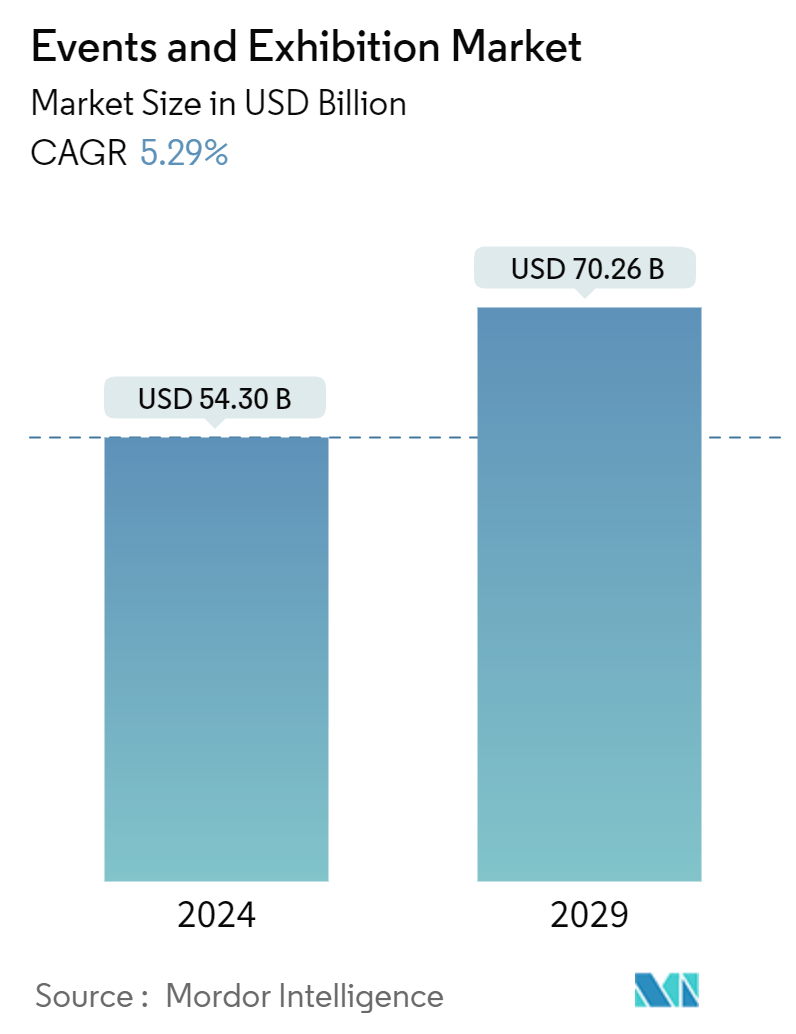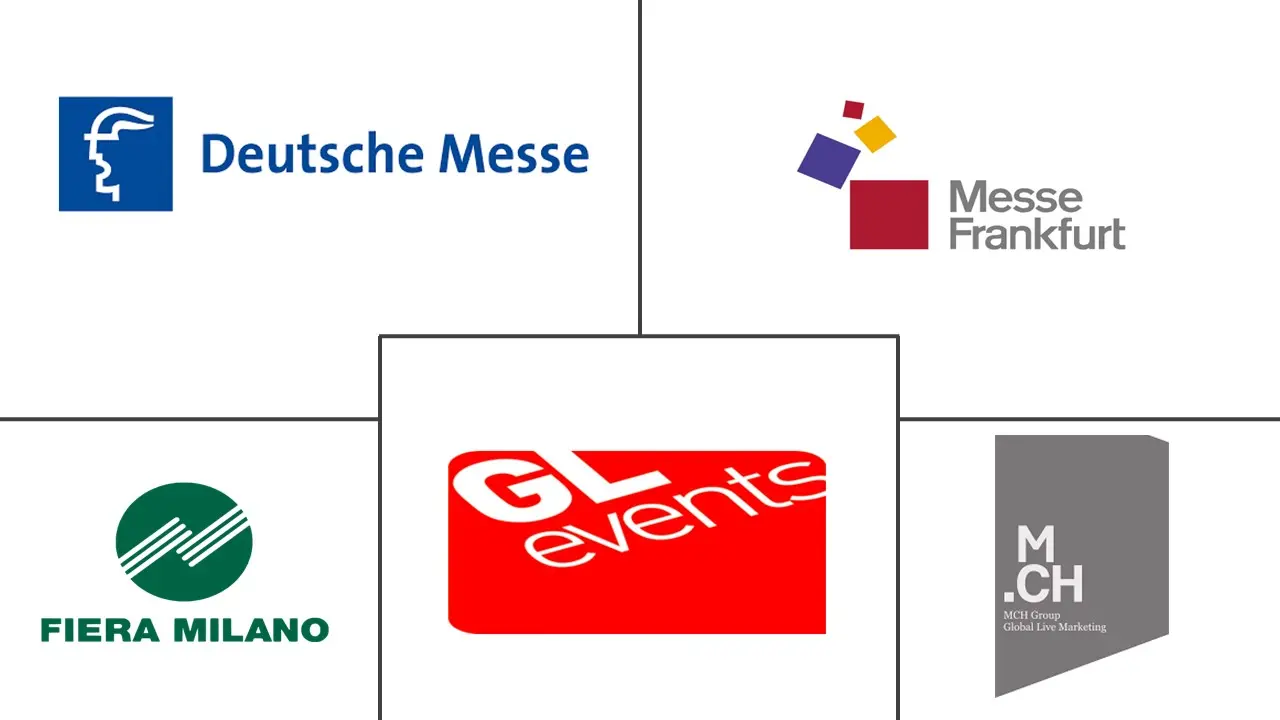Market Size of Events And Exhibition Industry

| Study Period | 2019 - 2029 |
| Market Size (2024) | USD 54.30 Billion |
| Market Size (2029) | USD 70.26 Billion |
| CAGR (2024 - 2029) | 5.29 % |
| Fastest Growing Market | Asia Pacific |
| Largest Market | Europe |
Major Players
*Disclaimer: Major Players sorted in no particular order |
Events And Exhibition Market Analysis
The Events And Exhibition Market size is estimated at USD 54.30 billion in 2024, and is expected to reach USD 70.26 billion by 2029, growing at a CAGR of 5.29% during the forecast period (2024-2029).
- Events and exhibitions serve as a potent marketing strategy. They offer a platform to showcase and promote products or services to an audience that may need to become more familiar with the customer's offerings. Additionally, they provide a valuable opportunity to engage with both current and prospective customers. By carefully planning and preparing for exhibitions, businesses can effectively introduce new products or services and generate significant brand visibility. The growing demand for trade fairs, which has resulted in the expansion of facilities for participants, is a crucial factor contributing to the market's growth.
- The event and exhibition industry has witnessed substantial growth in the past few years. This growth can be attributed to various factors, including the rise in corporate expenditure on marketing and branding, advancements in technology that have enhanced the overall event experience, and the growing trend of experiential marketing. Moreover, globalization has played a significant role in expanding the reach and scale of events, thereby contributing to the expansion of the market. Furthermore, maintaining the quality and credibility of the event experience necessitates professionalism in the exhibition market, which entails adhering to industry standards and best practices.
- Exhibitions and events hold immense value for businesses as they facilitate direct interaction and provide extensive networking opportunities. With the advent of new virtual platforms, the integration of artificial intelligence (AI) in the form of chatbots, matchmaking systems, and various other applications has become a common practice among event organizers. Since the outbreak of the coronavirus epidemic, virtual events have gained prominence and are gradually becoming the standard. Business owners, marketers, and event planners can no longer overlook the significance of AI in this evolving landscape.
- The industry experiences significant growth due to several factors, such as trade shows, exhibitions, digital activation, sports leagues, rural expansion, and government-initiated projects. Additionally, the industry benefits from IP (intellectual property), personal events, product launches, expansion of mini-metros, and below-the-line marketing spending. Furthermore, the market’s growth is driven by increasing demand for live experiences, technological advancements that enhance attendee engagement, and the emergence of experiential marketing. As individuals increasingly seek immersive and interactive experiences, companies are investing in events and exhibitions to establish deeper connections with their target audience.
- In addition, the exhibition sector is currently undergoing a swift shift toward immersive encounters, incorporating cutting-edge technologies such as virtual and augmented reality to engage and enthrall attendees. The prevalence of eco-friendly designs and practices is also on the rise, reflecting a growing focus on environmental accountability. Sustainability remains a recurring theme within the industry. Moreover, globalization has proven advantageous for the sector as companies extend their influence and strive to establish a foothold in new markets through events and exhibitions. This expansion is projected to persist as organizations acknowledge the significance of in-person interactions in an increasingly digital era.
- Additionally, production costs and operating expenses can be substantial, resulting in reduced profit margins and posing challenges for businesses to remain viable and competitive in the market. Small businesses in the event and exhibition sectors may encounter hurdles such as costly booth fees, restricted marketing resources, stringent qualification criteria, and diminished visibility in comparison to larger corporations.
- Following the COVID-19 pandemic, entertainment events like film festivals, music festivals, concerts, and world tours by musicians are becoming increasingly popular, presenting lucrative opportunities for the market. The event and exhibition industry is anticipated to experience a resurgence in growth in the coming years.
Events And Exhibition Industry Segmentation
- Events and exhibitions serve as potent marketing instruments. They offer an opportunity to showcase and advertise a product or service to an audience that may possess limited or no awareness of the offerings. The events and exhibition market is segmented by type, revenue stream, end user, and geography. By type, the market is divided into B2B, B2C, and mixed/hybrid. By revenue stream, the market is segmented into exhibitor fees, sponsorship fees, entrance fees, and services. By end user, the market is divided into the consumer goods and retail sector, automotive and transportation sector, industrial, entertainment, real estate and property, hospitality sector, and other end-users like healthcare and pharmaceutical. By geography, the market is divided into North America [United States, Canada], Europe [Germany, United Kingdom, France, and Rest of Europe], and Asia-Pacific [China, Japan, India, South Korea, and Rest of Asia-Pacific], Latin America, and Middle East and Africa). For each segment, the market sizing and forecasts were made on the basis of value (in USD).
| By Type | |
| B2B | |
| B2C | |
| Mixed/Hybrid |
| By Revenue Stream | |
| Exhibitor Fee | |
| Sponsorship Fee | |
| Entrance Fee | |
| Services |
| By End User | |
| Consumer Goods and Retail Sector | |
| Automotive and Transportation Sector | |
| Industrial | |
| Entertainment | |
| Real Estate and Property | |
| Hospitality Sector | |
| Other End Users |
| By Geography*** | |||||||
| |||||||
| |||||||
| |||||||
| Latin America | |||||||
| Middle East and Africa |
Events And Exhibition Market Size Summary
The events and exhibition market is poised for significant growth, driven by its role as a powerful marketing tool that facilitates product and service promotion while engaging current and prospective customers. The industry's expansion is fueled by increased corporate spending on marketing, technological advancements enhancing event experiences, and the rise of experiential marketing. Globalization has further broadened the reach and scale of events, contributing to market growth. The integration of artificial intelligence and virtual platforms has become commonplace, especially post-pandemic, as businesses seek to leverage these technologies to enhance attendee engagement and streamline event operations. The market's growth is also supported by diverse factors such as trade shows, digital activations, and government initiatives, which collectively drive demand for live experiences and immersive encounters.
In the entertainment sector, events and exhibitions are gaining traction as they offer live shows, interactive experiences, and opportunities for extensive networking. Countries like the United Kingdom, India, and the United States are key contributors to this growth, with their vibrant entertainment industries hosting numerous events. The resurgence of live events post-COVID-19 has further bolstered the market, with music festivals, film festivals, and sports events becoming increasingly popular. The exhibition market is also expanding in regions like China and Japan, driven by economic development and urbanization, which have spurred demand for business events and trade shows. The fragmented nature of the market sees various regional and global players adopting strategic partnerships and acquisitions to enhance their offerings and maintain a competitive edge.
Events And Exhibition Market Size - Table of Contents
-
1. MARKET DYNAMICS
-
1.1 Market Overview
-
1.2 Industry Attractiveness - Porter's Five Forces Analysis
-
1.2.1 Bargaining Power of Suppliers
-
1.2.2 Bargaining Power of Buyers
-
1.2.3 Threat of New Entrants
-
1.2.4 Intensity of Competitive Rivalry
-
1.2.5 Threat of Substitutes
-
-
1.3 Assessment of the Impact of COVID-19 on the Market
-
-
2. MARKET SEGMENTATION
-
2.1 By Type
-
2.1.1 B2B
-
2.1.2 B2C
-
2.1.3 Mixed/Hybrid
-
-
2.2 By Revenue Stream
-
2.2.1 Exhibitor Fee
-
2.2.2 Sponsorship Fee
-
2.2.3 Entrance Fee
-
2.2.4 Services
-
-
2.3 By End User
-
2.3.1 Consumer Goods and Retail Sector
-
2.3.2 Automotive and Transportation Sector
-
2.3.3 Industrial
-
2.3.4 Entertainment
-
2.3.5 Real Estate and Property
-
2.3.6 Hospitality Sector
-
2.3.7 Other End Users
-
-
2.4 By Geography***
-
2.4.1 North America
-
2.4.1.1 United States
-
2.4.1.2 Canada
-
-
2.4.2 Europe
-
2.4.2.1 Germany
-
2.4.2.2 United Kingdom
-
2.4.2.3 France
-
-
2.4.3 Asia-Pacific
-
2.4.3.1 China
-
2.4.3.2 Japan
-
2.4.3.3 India
-
2.4.3.4 South Korea
-
2.4.3.5 Australia and New Zealand
-
-
2.4.4 Latin America
-
2.4.5 Middle East and Africa
-
-
Events And Exhibition Market Size FAQs
How big is the Events And Exhibition Market?
The Events And Exhibition Market size is expected to reach USD 54.30 billion in 2024 and grow at a CAGR of 5.29% to reach USD 70.26 billion by 2029.
What is the current Events And Exhibition Market size?
In 2024, the Events And Exhibition Market size is expected to reach USD 54.30 billion.

